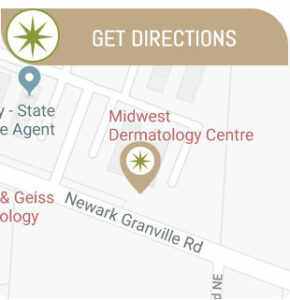What is the Cause of Shin Spots (Diabetic Dermopathy)?
At Midwest Dermatology Centre, our skilled professionals provide expert care for shin spots, also known as diabetic dermopathy, a common skin condition associated with diabetes. These small, brownish patches on the shins are caused by changes in blood vessels due to prolonged high blood sugar levels. Our team offers personalized guidance to help manage your skin health and improve circulation for better healing. Please contact us today to schedule a consultation. Our dermatology clinic is located at 1959 Newark-Granville Road, Granville, OH 43023. Let us support you in achieving healthier, more confident skin!


Table of Contents:
Are shin spots permanent?
Are shin spots caused by poor blood circulation?
How does prolonged diabetes increase the risk of shin spots?
What preventive measures can reduce the risk of developing shin spots?
While generally benign, shin spots can be bothersome and challenging to manage. We offer a comprehensive approach to treatment, focusing on both lifestyle modifications and medical interventions. Our experienced dermatologists recommend strategies such as elevating the legs, wearing compression stockings, and incorporating regular exercise to enhance circulation and reduce spot visibility. We also emphasize the importance of managing underlying conditions like venous insufficiency, hypertension, diabetes, or heart disease, which can exacerbate the issue.
We encourage anyone dealing with shin spots or related concerns to schedule a consultation at Midwest Dermatology Center. Our specialists are here to discuss personalized treatment options and support you in achieving healthier, clearer skin. By addressing both the symptoms and root causes.
At Midwest Dermatology Center, we recognize the importance of addressing skin conditions that may indicate underlying health issues. One such condition is the appearance of reddish-brown spots on the lower legs, commonly referred to as shin spots, stasis dermatitis, or pigmented purpuric dermatosis. These spots are often linked to poor blood circulation in the lower extremities, which can be a sign of chronic venous insufficiency.
Chronic venous insufficiency occurs when the veins in the legs struggle to send blood back to the heart effectively. This is often due to weakened or damaged valves in the veins, leading to blood pooling in the lower legs. As a result, increased pressure can cause fluid to leak into surrounding tissues, resulting in inflammation and the development of shin spots. Without proper management, these spots can become itchy, and scaly, and may even lead to open sores.
We understand that poor blood circulation is a significant factor in the development of shin spots. Several risk factors can contribute to poor circulation, including:
● Obesity
● Pregnancy
● Prolonged standing or sitting
● Wearing tight clothing
● Smoking
● High blood pressure
● Diabetes
● Sedentary lifestyle
● History of blood clots or varicose veins
To effectively manage shin spots, it’s essential to improve circulation and reduce venous pressure. Our team can provide you with personalized recommendations to enhance your vascular health.
We understand the intricate challenges faced by our patients with prolonged diabetes, particularly concerning skin health. One common yet often overlooked condition is diabetic dermopathy or shin spots. These skin changes highlight the need for comprehensive dermatological care tailored to the unique needs of diabetic patients.
Understanding the Condition:
● Vascular and Metabolic Changes: Chronic high blood sugar levels can lead to microangiopathy, reducing blood flow and affecting skin health. This impacts the skin’s ability to heal and increases vulnerability to shin spots.
● Advanced Glycation End Products (AGEs): AGEs, formed due to prolonged hyperglycemia, weaken skin structure, reducing elasticity and strength. Managing blood sugar levels can help prevent these effects.
● Immune System Support: A weakened immune system can increase the risk of skin infections and lesions. Strategies to enhance immune health are essential to reduce these risks.
● Peripheral Neuropathy: Damage to peripheral nerves may result in unnoticed injuries, contributing to shin spots. Early detection and intervention can help minimize this risk.
Management Strategies:
● Glycemic Control: Collaborating with primary care providers, we emphasize the importance of maintaining optimal blood glucose levels to prevent or reduce the severity of diabetic dermopathy.
● Skin Care Regimen: We offer personalized skin care plans, including recommendations for moisturizers and protective measures to maintain skin health and prevent injuries.
● Footwear Guidance: Recognizing the role of proper footwear in preventing pressure sores, we provide guidance on selecting comfortable, well-fitting shoes.
● Medical Interventions: For more severe cases, our team can prescribe topical treatments and ensure early intervention for any skin changes, reducing the risk of complications.
Shin spots, also known as pigmented purpuric dermatosis or Schamberg’s disease, are common concerns for many of our patients. These small reddish-brown patches, typically harmless, can be aesthetically concerning and sometimes confused with conditions like erythema nodosum. Our team is dedicated to providing you with expert advice on preventing these skin issues through comprehensive care and lifestyle adjustments.
● Promote Healthy Circulation:
○ Engage in regular activities like walking, swimming, or cycling to enhance blood flow and prevent pooling in the legs.
○ Avoid prolonged sitting or standing and elevate your legs periodically to improve circulation.
○ Consider using compression stockings to reduce blood pooling and improve overall circulation.
● Protect Your Skin and Legs:
○ Prevent trauma to the skin by wearing protective clothing and avoiding bruises or cuts.
○ Choose comfortable, well-fitting shoes to avoid unnecessary pressure on your legs and feet.
● Focus on Hydration and Skincare:
○ Drink plenty of water to keep your skin hydrated and maintain elasticity.
○ Use fragrance-free, hypoallergenic moisturizers to keep the skin nourished and reduce irritation.
○ Opt for gentle skincare products to avoid harsh chemicals that may irritate sensitive skin.
● Maintain a Healthy Diet and Weight:
○ Incorporate a balanced diet rich in vitamins and antioxidants to support blood vessel health.
○ Maintain a healthy weight to minimize pressure on the lower extremities and improve circulation.
● Avoid Irritants and Allergens:
○ Limit exposure to known skin irritants and allergens to prevent flare-ups or irritation.
○ Wear loose, breathable fabrics to reduce friction and skin sensitivity.
● Manage Underlying Health Conditions:
○ Monitor and control conditions like diabetes, hypertension, and venous insufficiency to prevent complications.
○ Regular check-ups and effective management of these conditions can significantly improve skin and leg health.
At Midwest Dermatology Center, our goal is to empower you with the knowledge and resources to maintain healthy skin and circulation. Contact us today to schedule a consultation and learn more about our comprehensive dermatological services. We welcome new patients at 1959 Newark-Granville Road Granville, OH 43023. We serve patients from Granville OH, Park Ridge OH, Welsh Hills OH, Newark OH, Alexandria OH, Pataskala OH, and surrounding areas.
Additional Services You May Need
▸ Restylane
▸ Hair & Scalp Treatment
▸ Botox Treatment
▸ Skin Cancer Treatment
▸ Eczema & Dermatitis
▸ IPL Laser Treatment
▸ Keratosis Treatment
▸ Skin Color Treatment
▸ Psoriasis & Rash Treatment
▸ Hair Loss Treatment
▸ Skin Treatment for Diabetics
▸ Acne & Rosacea Treatment
▸ Pelleve Treatment
▸ PelleFirm Treatment
Additional Services You May Need
▸ Restylane
▸ Hair & Scalp Treatment
▸ Botox Treatment
▸ Skin Cancer Treatment
▸ Eczema & Dermatitis
▸ IPL Laser Treatment
▸ Keratosis Treatment
▸ Skin Color Treatment
▸ Psoriasis & Rash Treatment
▸ Hair Loss Treatment
▸ Skin Treatment for Diabetics
▸ Acne & Rosacea Treatment
▸ Pelleve Treatment
▸ PelleFirm Treatment






